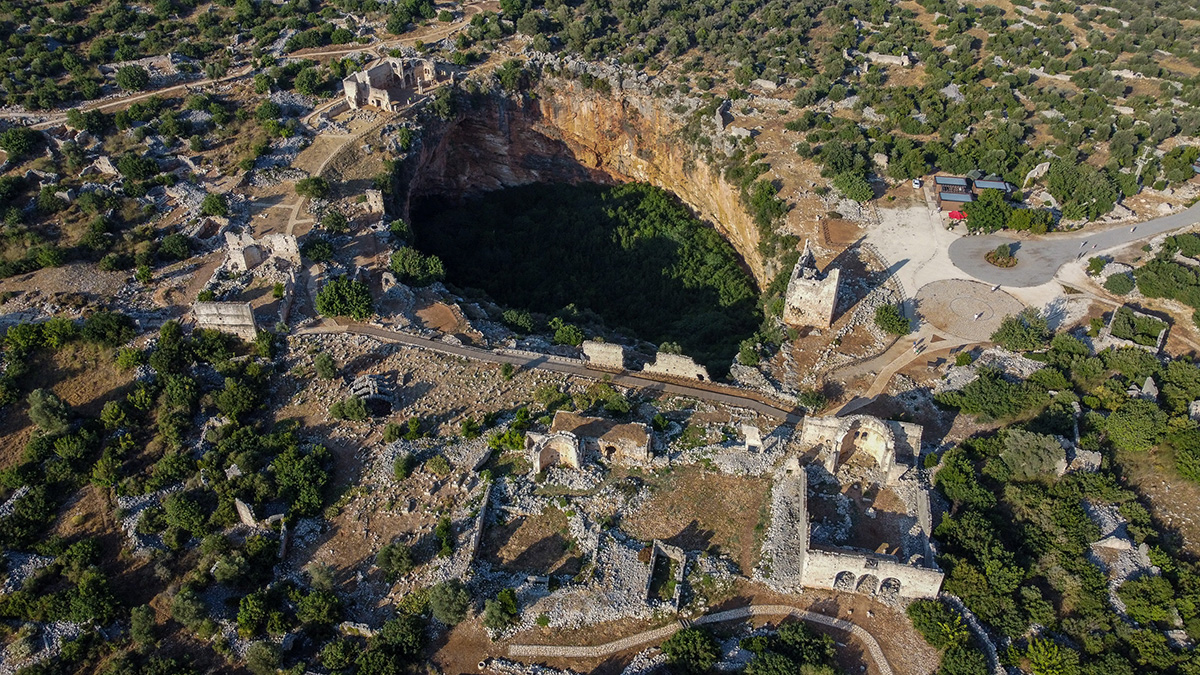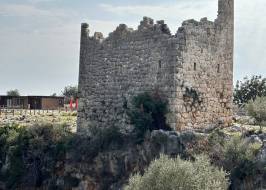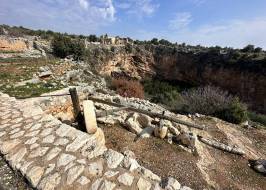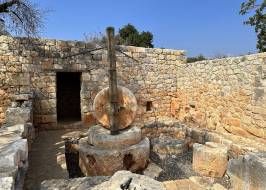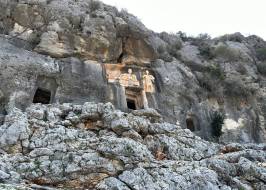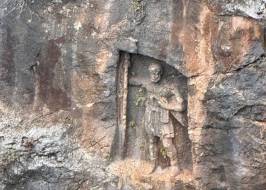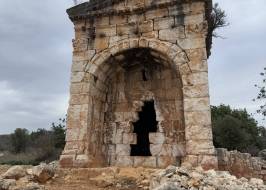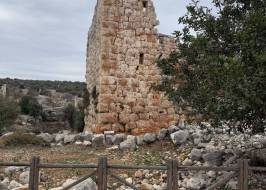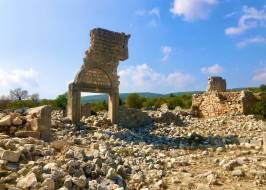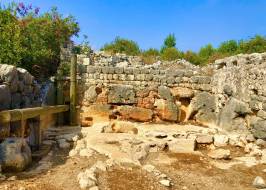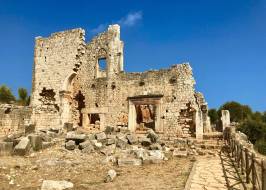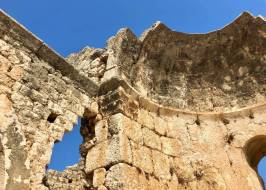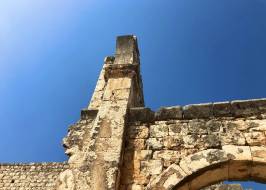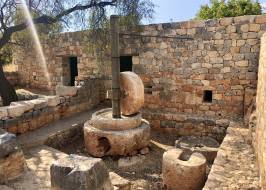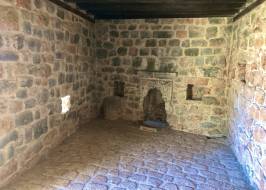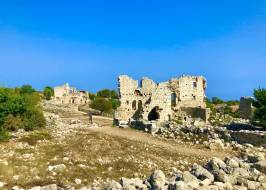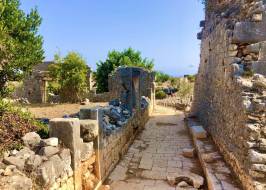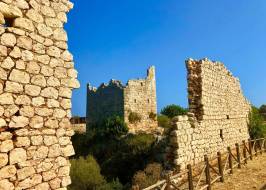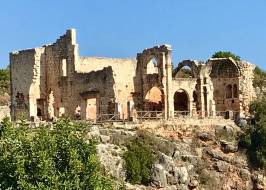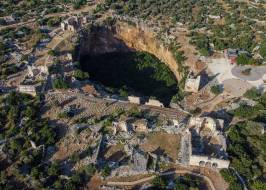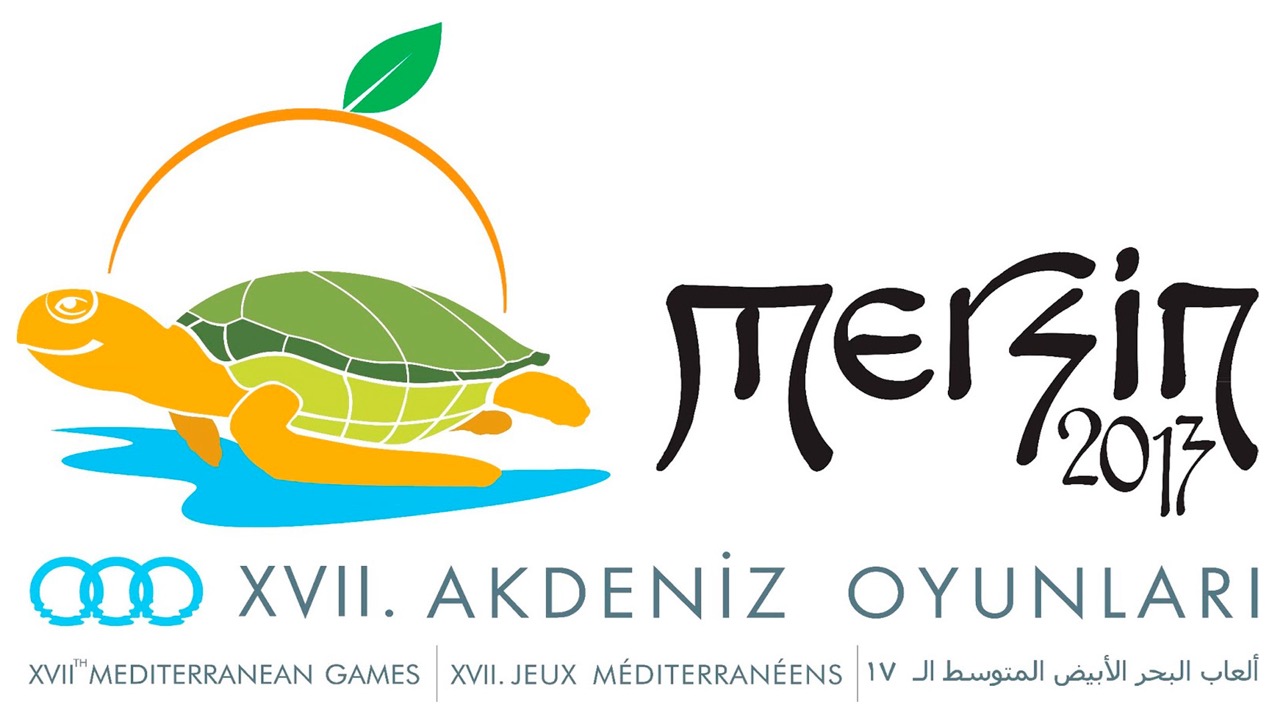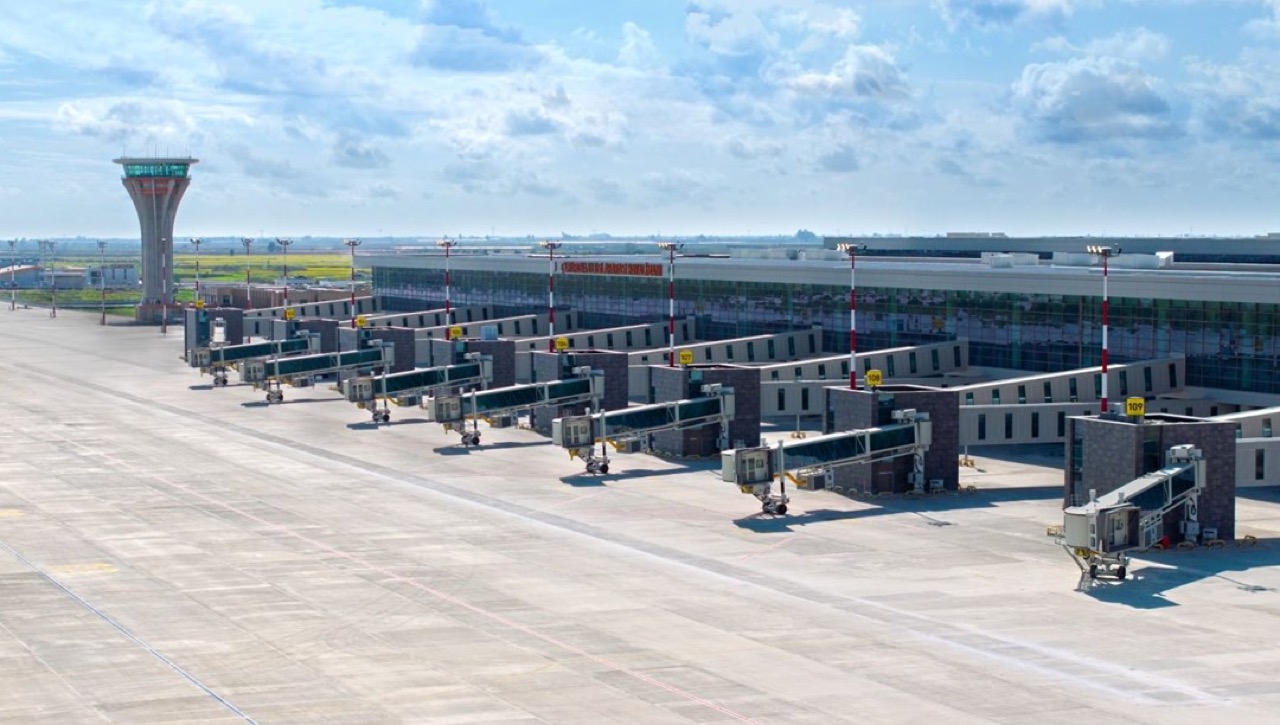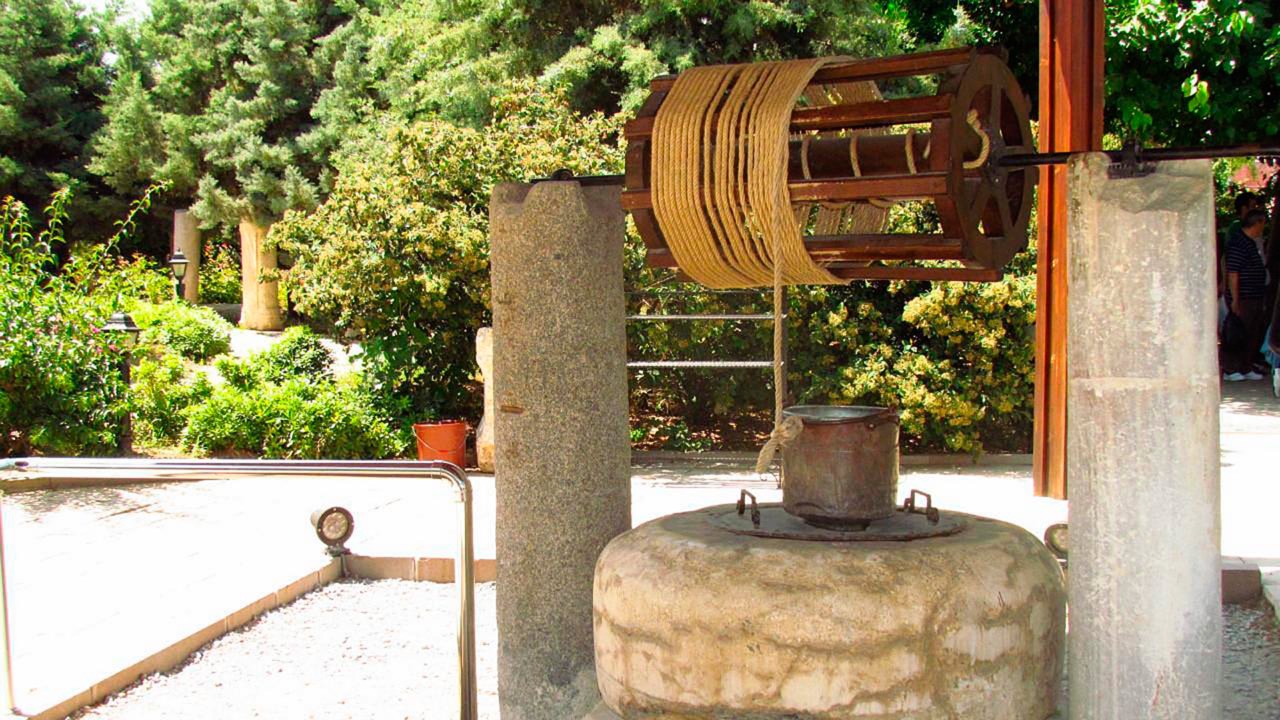On the edge of the deep karst funnel, as if perishing on the very edge of the abyss, the ancient city of Kanlydivan, in the Erdemly region, the village of Ayash, between the cities of Selifka and Mercin, is located.
Kanlydivan, ancient Kanitelis, is completely abandoned today, although in the 19th century he was inhabited by Yoryuki, the Turkmen tribe, who called this place "Kanaida". Various fossils of marine life, especially shells and sea stars, suggest that this place was connected with the sea.
This place, in addition to its rich history, amazes the imagination with a unique geographical position. The city itself seems part of a grandiose natural amphitheater formed by a karst funnel.
The ruins of this place have survived for 2000 years, and some of them were marked with the 2-3 centuries BC.
Kanlydivan was not always called that, the name of the times of the Roman and Byzantine empires. Previously, this place was called Kanyatelis.
Both of these names can be translated as “red” or “bloody” and “hole” or “madness”. The funnel has a red shade of rocks, also, according to beliefs, they threw off criminals here, so they are a failure and consider it “bloody”.
On the territory of the Old City, the ruins of the 2nd century BC tower, olive workshops, where olive oil, four churches, basilica were mined.
The Hellenistic Tower is the first structure at the entrance to Kanlydivan.

A Hellenistic tower is 17 meters in size of 15 by 9, stands on the southern edge of the Holy abyss. This dilapidated structure was built entirely from polygonal masonry and was used as a dwelling to the early Byzantine time. Three -story, it has a small narrow arched door installed in the eastern wall. There are no windows on the ground floor, while the upper two floors that were divided into three rooms have small openings. Two inscriptions on the seventh and ninth corner blocks (counting from below) on the southwestern corner of the tower indicate that it was dedicated to Zeus Olbios on behalf of the Olvian tsar-priest Tevra, the son of Tarkiar, about 200 BC.
- On the tenth cornerstone, Triskeles is carved (three legs). The same sign appears on coins as the emblem of the Olvian kingdom.
Holy abyss or bloody canyon
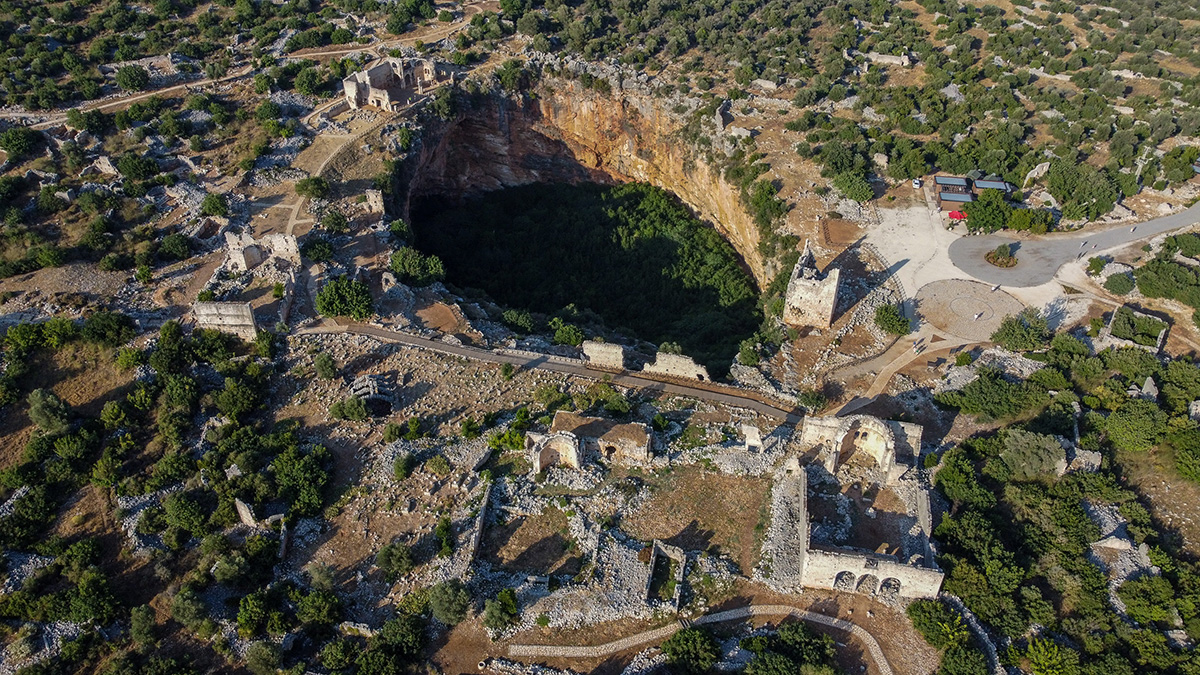
A huge natural cavity (90 meters by 70 by 60 meters), known as a holy abyss, in ancient times was considered sacred and was dedicated to the cult of Zeus Olbia. The rocky walls were steep, but there were two entrances, one cut down in a rock under the Hellenistic Tower on the south side, and the other - the tunnel, which goes under the Church of the papalos on the northern edge of the hollow.
Two bas -reliefs are carved inside the abyss.
Red bas -relief - relief of the Armaronks family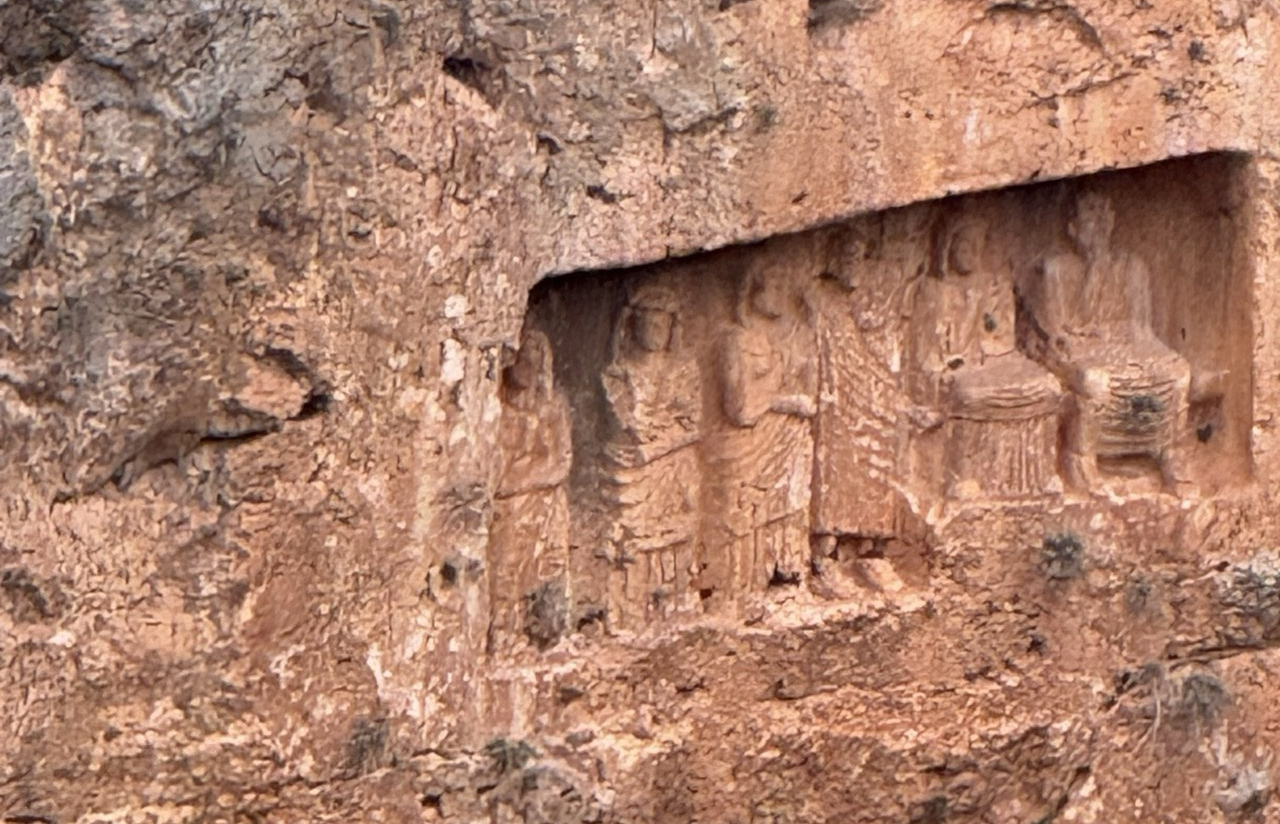 is best observed from the center of the western side of the hollow, the relief is carved on the surface of the northern cliff in a niche of 4 metro are 2 meters. Barbaric in style and rude in execution, his strongly blurred five -line inscription in the right corner contains the name of the family Armaronksas. It depicts a family of six people: father and mother are sitting over four children (son and three daughters), dressed in toars and covered with veils.
is best observed from the center of the western side of the hollow, the relief is carved on the surface of the northern cliff in a niche of 4 metro are 2 meters. Barbaric in style and rude in execution, his strongly blurred five -line inscription in the right corner contains the name of the family Armaronksas. It depicts a family of six people: father and mother are sitting over four children (son and three daughters), dressed in toars and covered with veils.
The bas -relief is dated to the first century BC. And even today, a way is surprising to perform this bas -relief on a steep cliff, high above the abyss.
The relief of the warrior is a less noticeable bas -relief, so do not write off when visiting Kanlydivan. There are many secrets here. 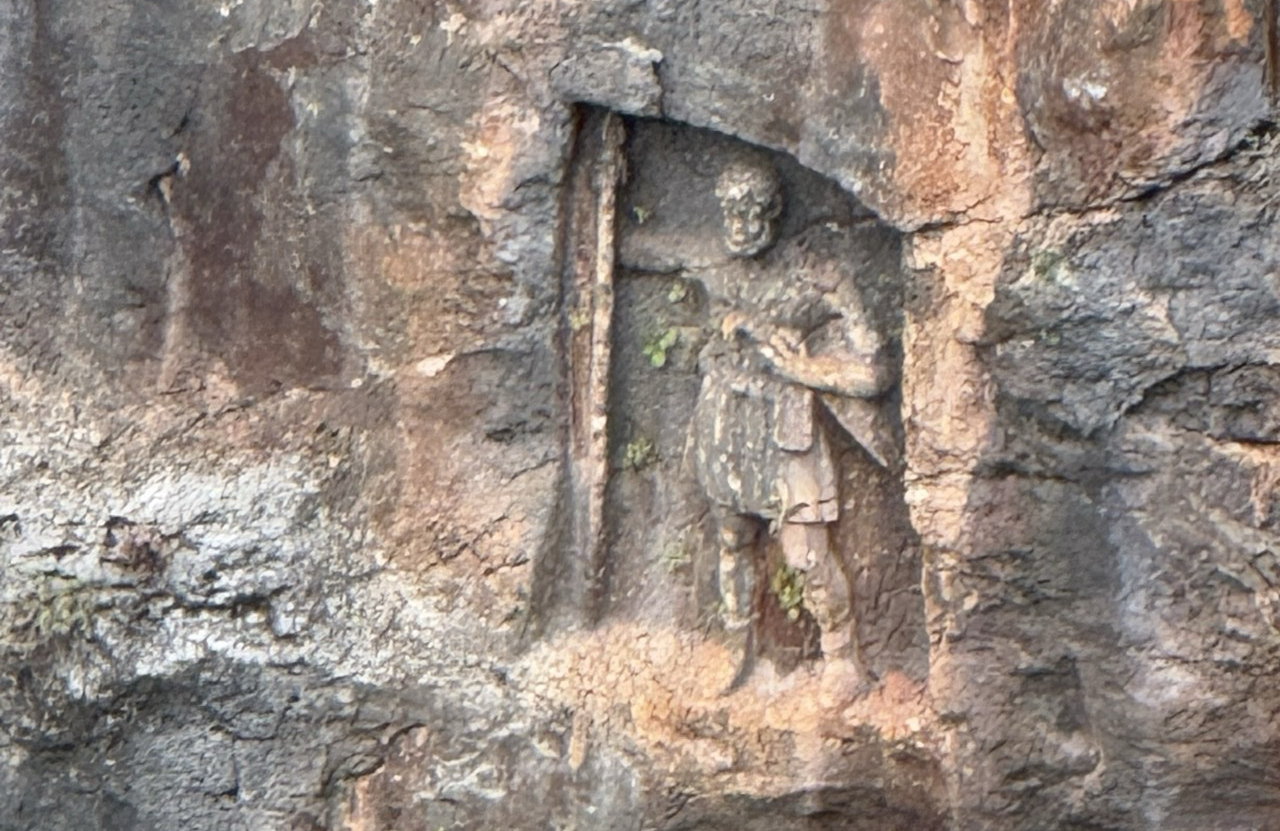 The early Roman relief of the warrior shows a standing figure and carved below on the northwest rock. The inscription in which the warrior is called Togom is almost erased.
The early Roman relief of the warrior shows a standing figure and carved below on the northwest rock. The inscription in which the warrior is called Togom is almost erased.
- From the western and northern part of the funnel, there are an olive oil workshop.
Olive oil workshops.
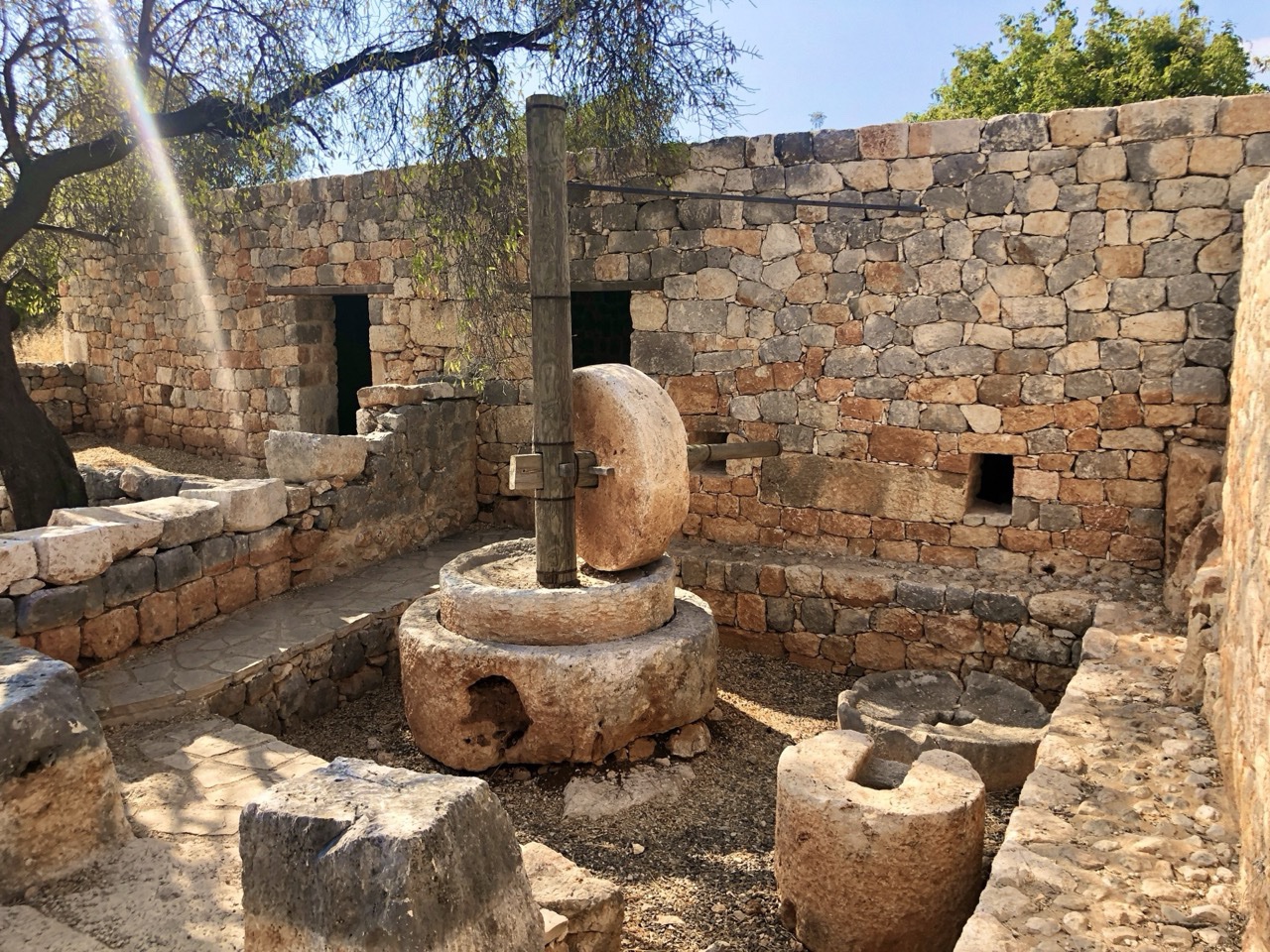
It has a square plan with dimensions of 7 meters per 6 meters. The northern wall of the building is located on a rock. There are two niches for pressing in the northern wall, carved in a rock on which wooden beams are placed. This shows that two pressed mechanisms work together in one workshop. Therefore, it is called "masterful twin." In the upper parts of the stone walls there are traces of holes indicating the use of wooden beams for the construction of the roof. This shows that the workshop is preserved to the level of the roof in some sections.
The floor has pressing beds of each mechanism. Collective vat and channels located in front of the pressing beds are carved in rocky soil. They were used to collect a liquid squeezed from crushed seeds. A sinker in the form of a bell and a crushing platform were found on the territory of the workshop.
Churches of Kanitelis or Basilica Kanlydivan.
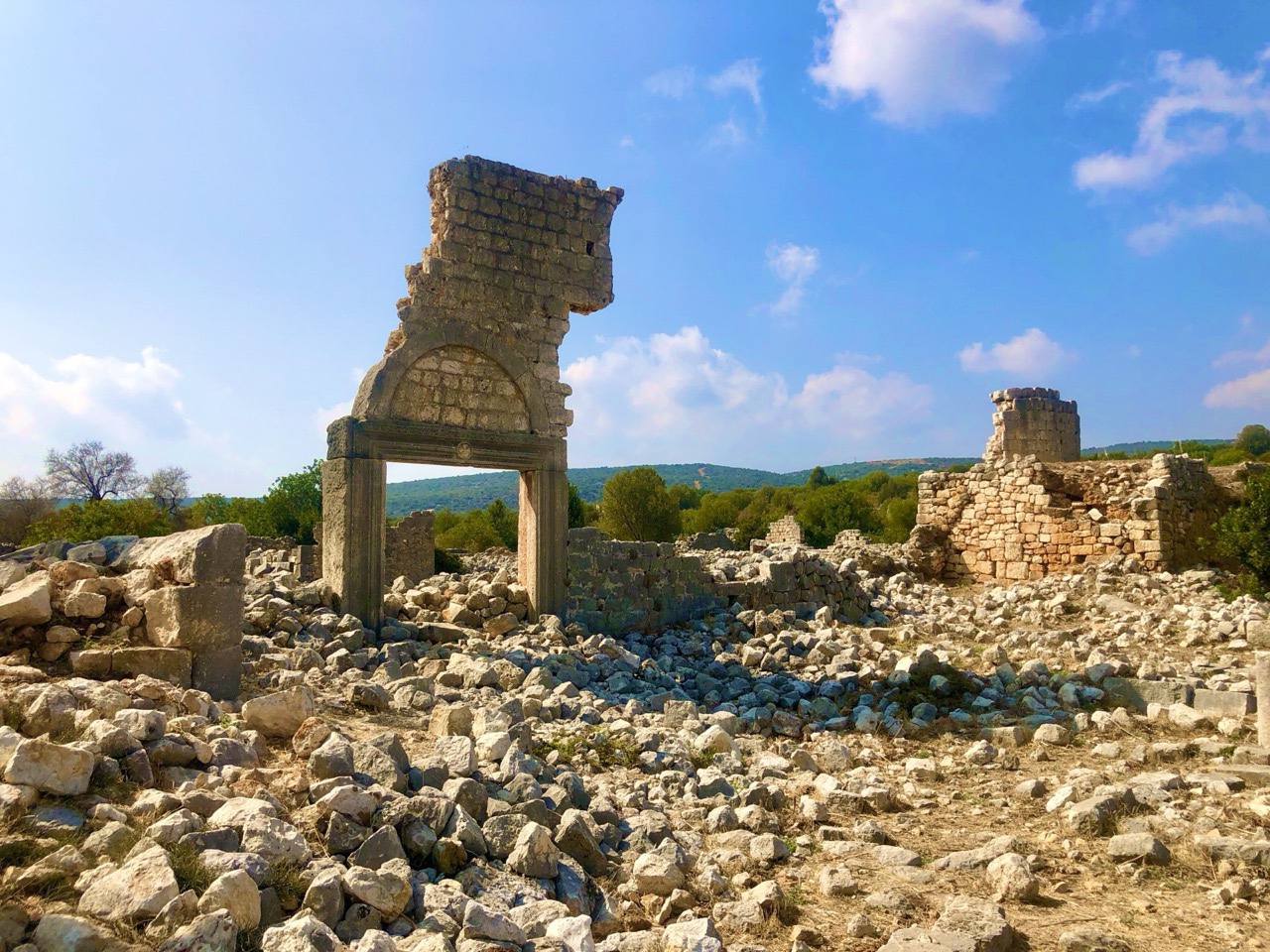
In Kanitelis, four Early Russian Basils and one chapel have been preserved. They belong to the end of the fifth beginning of the sixth century, when the city reached its peak in development. The well -preserved remains of basil at the abyss indicate that Canitelis developed in the era of late antiquity. Little is known about the decoration of these basils. In all cases, the main roofs consisted of wood and tiles. There is also a group of churches with yards. Nart was an ordinary feature of Canitelis basilic. In each sled there was the upper floor, which was preserved to a height sufficient to give this information. The upper floors provided a message between the galleries over the aisles. Stairs were usually located at the northern end of the Nartex or were attached to it. The sanctuaries have similar features on their main doors: the frames are made of stone in a monolith, jumpers carry the Byzantine cross in the center, and the columns are decorated with capitals carved in the Corinthian order.
- The first basilica, which stands west of the Hellenistic Tower, on the way leading to the AB GBT Temple, has three naves, two of which collapsed. The outer walls are well preserved. The main door at the western end, leading to Nartex, has three arches 2.8 meters wide, supported by two columns with Corinthian capitals. A cross is cut on the main door. The second door on the left opens into a three -nephic basilica, the dimensions of which are 25.2 meters by 18.3 meters. The remaining internal partitions connecting the aisles with the apsidal nefa collapsed.
- The second basilica is located north of the first. All that remains is her apse and several destroyed walls. Her plan shows some bumps that suggest that it could be a monastery.
- The third basil is northeast of the second sanctuary on an ancient paved road leading to necropolis. Its dimensions are 28.3 meters by 16.6 meters. Its external walls are well preserved, but the walls of its apsidal nave, two passes and the Nartex collapsed.
- The fourth basilica is the latest by date and the most richly decorated. It is known as the Church of Papalos and is located on the northern edge of the Holy abyss. Although its southern walls were completely collapsed, the rest of the basilica is in good state of safety. Her apse, pierced by double arched windows, separated by a small column, was previously decorated with a fresco with the image of four evangelists. There are two inscriptions on the jumper of the main door. The lower one tells us that the sanctuary was built as a papalos. The upper contains template phrases from the New Testament: “This is a door leading to God. People who enter are saved. My God, help me. "
Necropolitan

In addition to the sarcophagi lying on both sides of the road leading to the excavation site, the cemeteries are concentrated in two main areas and indicate a significant population of the city.
Northern necropolis
There are two temple tombs in North Necropolis standing among the sarcophagi. The most beautiful of the sarcophagi is with a jellyfish that stands on the right side of the new road leading to the village of Chanakchi. Its box is decorated on three sides. On the front side, three heads of the bull are depicted, interspersed with two human busts that decorate the space over garlands. On the sides of the same motives are cut, but with lion heads above the garlands. The head of the jellyfish, a symbol of power, is depicted on every triangular surface of the prismatic cover, which now, unfortunately, is broken in two on the ground.
Medusa
in Greco-Roman Mythology Medusa was the only mortal of the three Gorgon and was described as a terrible monster with snakes instead of hair. Anyone who looked at her turned into a stone.
There are many legends trying to explain its origin. According to some, Medusa was a beautiful girl who was very proud of her hair. To punish Medusa, Athena, the goddess of wisdom and victory, she turned her hair into a mass of snakes.
According to other sources, Athena punished Medusa, giving her a terrible appearance for the fact that she was sleeping with Poseidon, the god of the sea.
The death of Medusa has also become a topic for many legends. The most famous of them leads to the stage of the hero of Perseus, who, with the help of Athena, cuts off the head of Medusa, while, of course, showing extreme caution, so as not to look at the jellyfish due to fear, but using his polished shield as a mirror.
The shield of Athena, decorated with the head of Medusa, symbolizes her ability to turn opponents.
In ancient times, people of a high rank, such as emperors, commanders and similar ones usually adorned their shields and armor, as well as their tombs by the image of the head of Medusa.
Three -column tomb
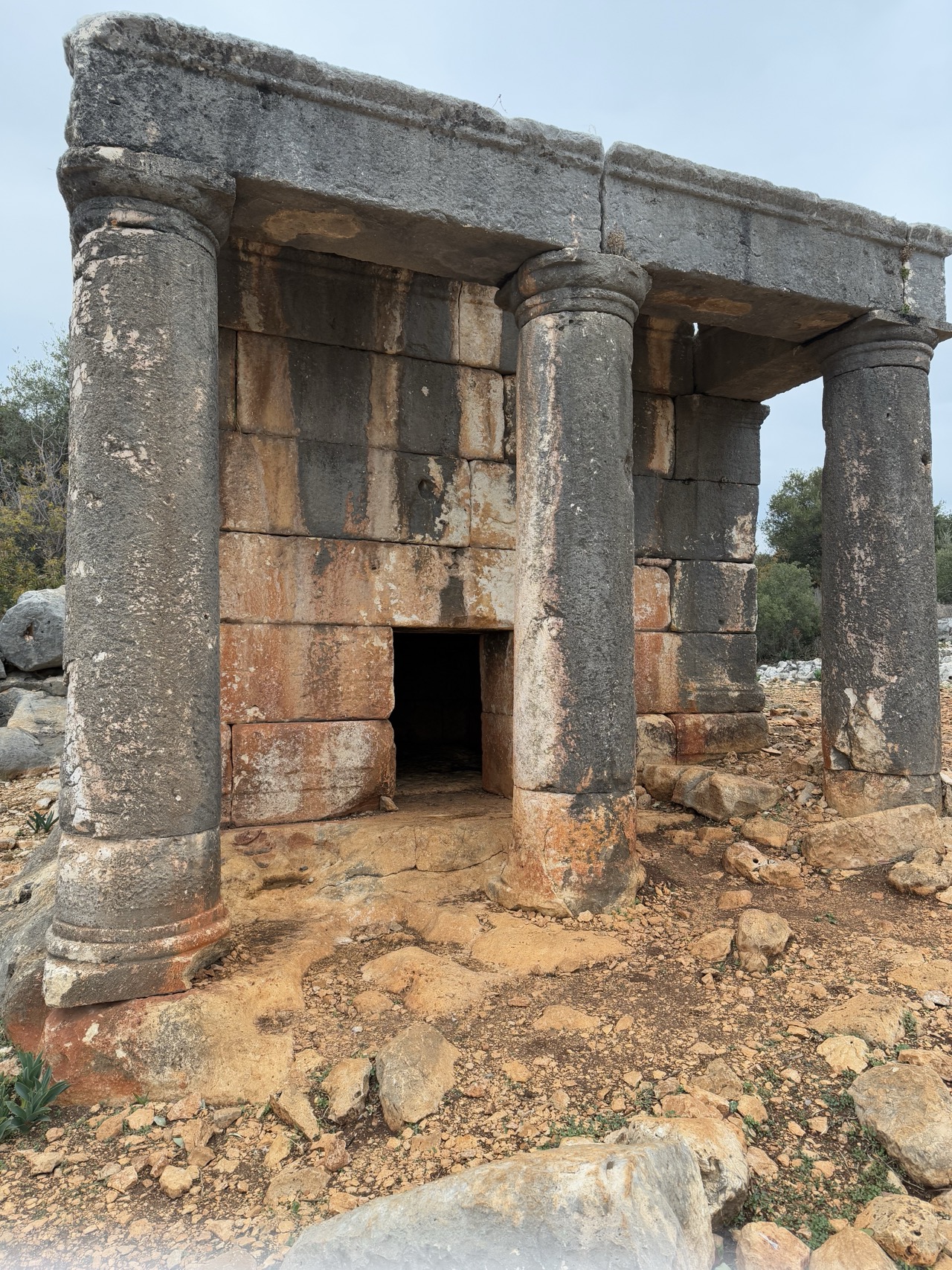
The tomb with three columns is about 100 meters east of the Aba Grobnitsa temple and has a size of 5.7 meters in length, 4.1 meters wide and 4 meters in height. This unusual design has a peristil of three columns 3 meters high, unlike four columns, usual for this region. The funeral chamber is empty and paved with stone blocks. It is assumed that the cubic temple dates from the 3rd or 4th century AD.
- A press or oil was adjacent to the tomb.
- Another similar temple tomb is located to the right of the entrance to the territory.
Tanks

In addition to small, two main tanks supplied Kanitelis with water. A covered tank with a width of 14.5 m per 10 m, supported by seven arches, is behind the second basilica. The second underground tank carved in a rock with a size of 10 m by 8 m has five arches and is located in the Turkish cemetery.
Monumental tomb of Aba
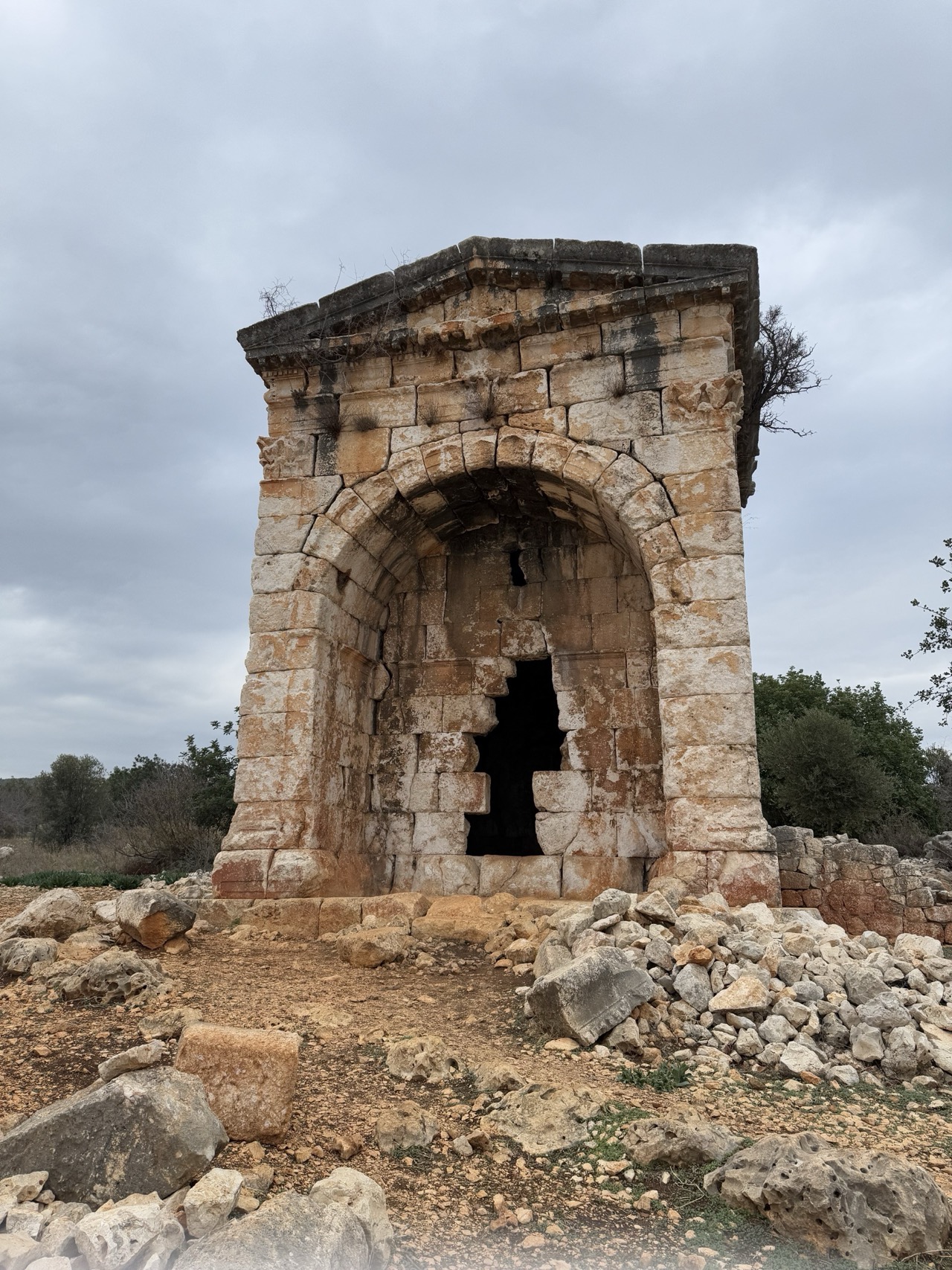
This is the most significant monumental tomb of Kanitellis, built on the model of Roman temples. According to the inscription above the entrance, he was built by a woman named Aba for herself and her husband Arios. The tomb is located above the low podium. Before the entrance there was a vaulted room. Between the vault and the pitched roof there is a batch backfill.
Dimensions of 7 meters by 8.63 meters and its height is 7.70 meters. There are Corinthian capitals on every corner of the building. Inside the building, stone beds are built into the stone walls. The building dates from the 2nd year of our era in accordance with the inscription located on the building, as well as in accordance with comparisons with other buildings in the region.
Inscription
“Like the daughter of Kalligonos and Katraios, I am Aba - in the name of my husband Arios - grandson Aria and son Nikanor and my children Nikanor and Arios. The request and order, so that no one is buried in the tomb of Arios, except for me. In the same way, no one will be buried after my death. Those who behaved against this will would have committed sin against the underground gods, both he and his people would have disappeared and would also be punished by 10,000 denarii for paying our Mr. Caesar, 8,000 denarii to the city of August and 2500 Denaria of the local administration of Kanitelis. I also wish my and my husband the orders and orders to end to infinity, and no one will shave this inscription or be punished "
In the entire territory of the old city, information plate and signs are installed, so you will not get lost!
The road to the old city is convenient, there is an organized parking for cars. This is a special difference between Kanlydivan and some other tourist places.
The necropolis of Chanakchi is an area of ancient tombs located in a lowland, which is 400 meters west of the Kanlydivan pit. On the facade of the rocky hill located in the south, there are 13 tombs carved in the rock and 6 reliefs. In addition to the tombs carved in the rock, there is a tomb, a monumental tomb in the shape of a temple, sarcophagus, chomosorium.
The relief of the first woman
A woman depicted in front is 1.90 meters of height, holds Himation above her head with his right hand, and covers her stomach with his left hand with a chemical. She occupies a pose, which was a symbol of sorrow and mourning.
The second woman, a man with an ax, a man in clothes
The dress of the second woman consists of a chiton and a chimat. It differs from the first female figure of both a standing position and a rough form of clothing. She demonstrates a simpler and more early stylistic work. The pose was a symbol of sadness and mourning, was presented on it. It is believed that it dates from the first century BC as the earliest relief of the necropolis.
The reliefs of a man lying on Klavin and a soldier.
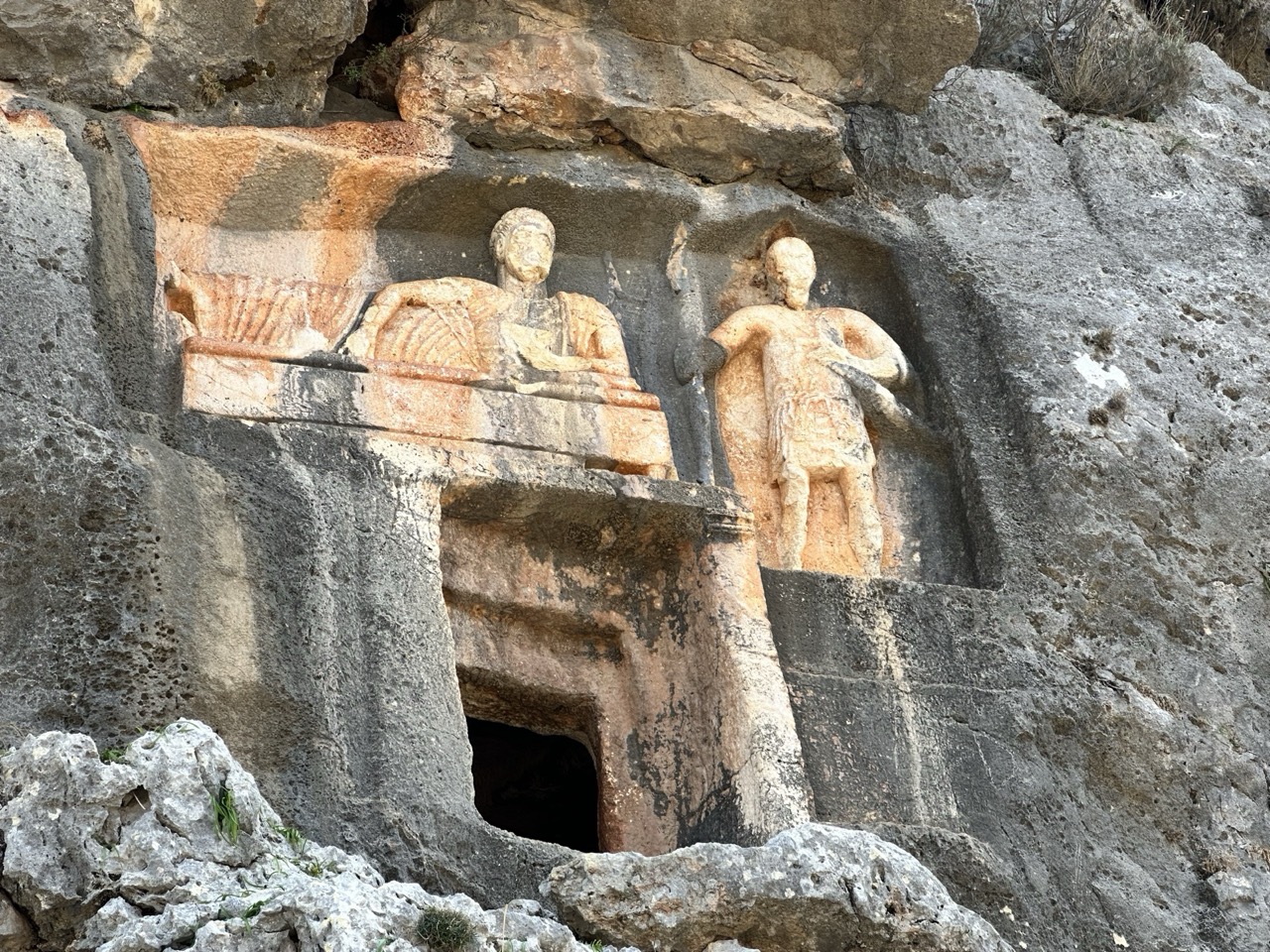
A person lying on a wedge holds a bowl in his hand. The figures lying on the wedge iconographically depicted the dead people who continued their peace and peace in another world. Families of rulers consisted of priest fathers and sons-soldiers in accordance with theocratic and military administration of the region. Similarly, a standing soldier on this relief could be the son of a governor priest. The relief dates from the first century of our era.
The relief of the mother-son and father
This is a family relief. They are located on each other, forming two relief spaces. In the upper niche is a man with two hands under chemistry. There are two figures in the lower niche. On the left is a boy, on the right is a woman holding chemistry above her head with his right hand. It dates from the 1st of our era.
Most of the reliefs date back to the first century BC.
Be sure to visit Kanlydivan in Mersin.

